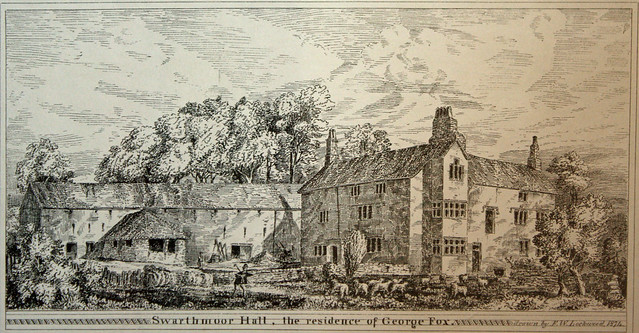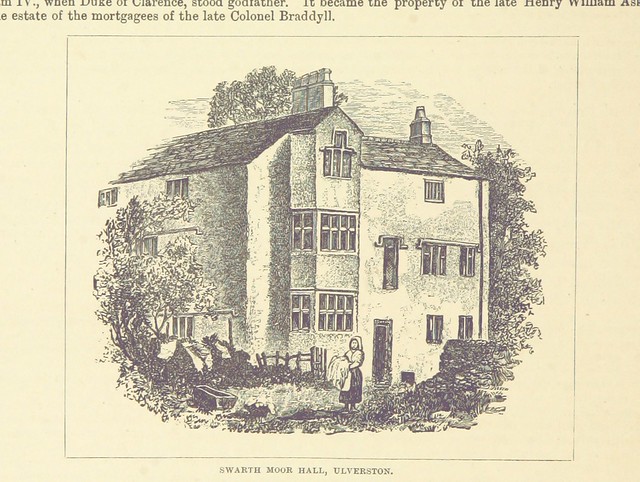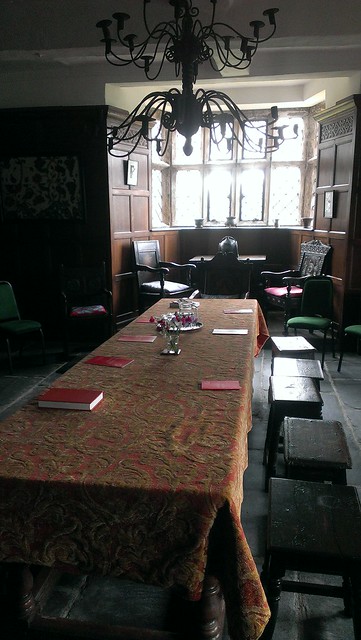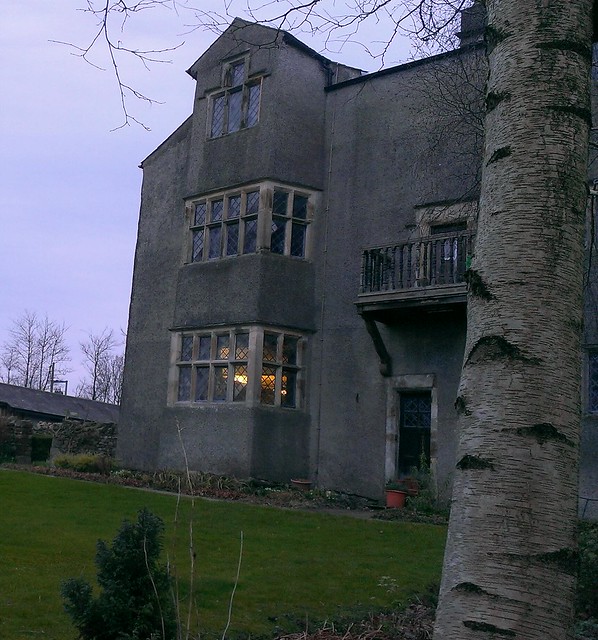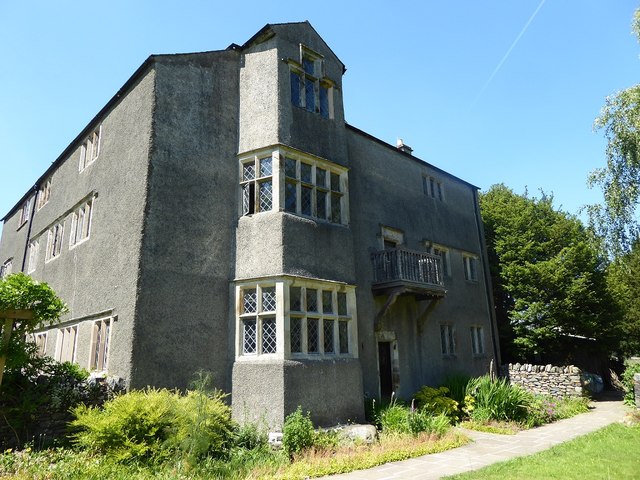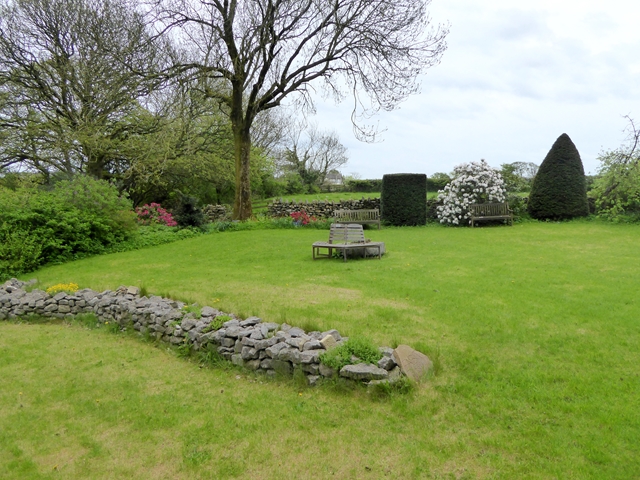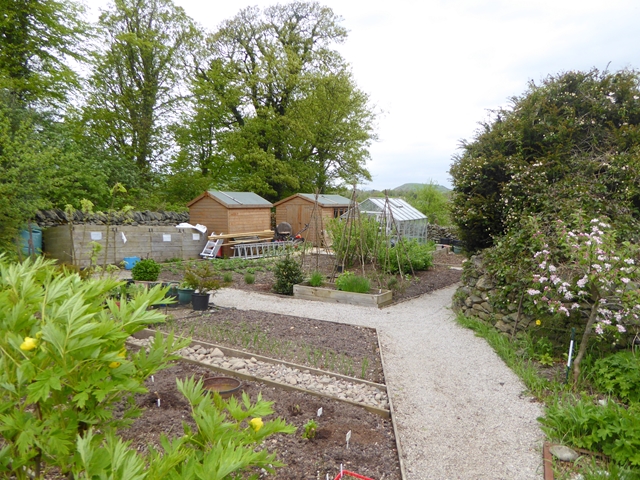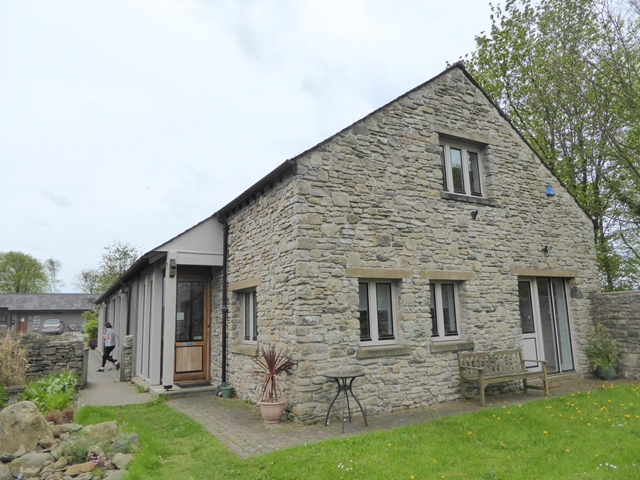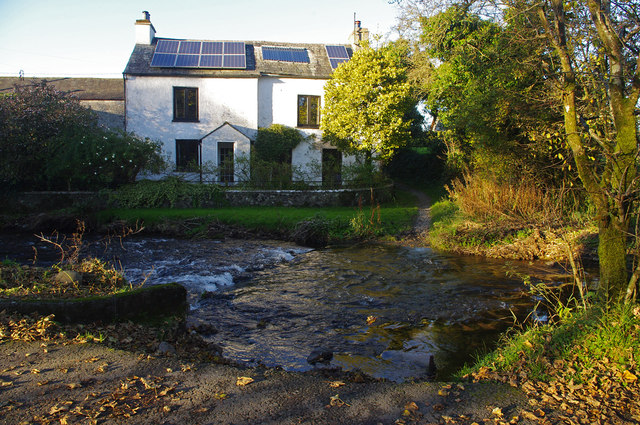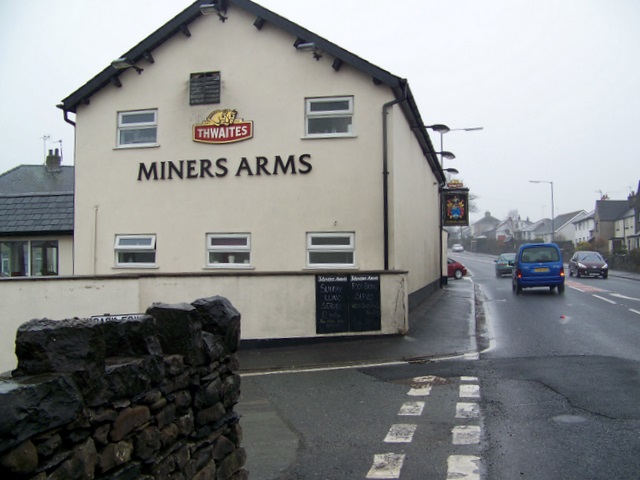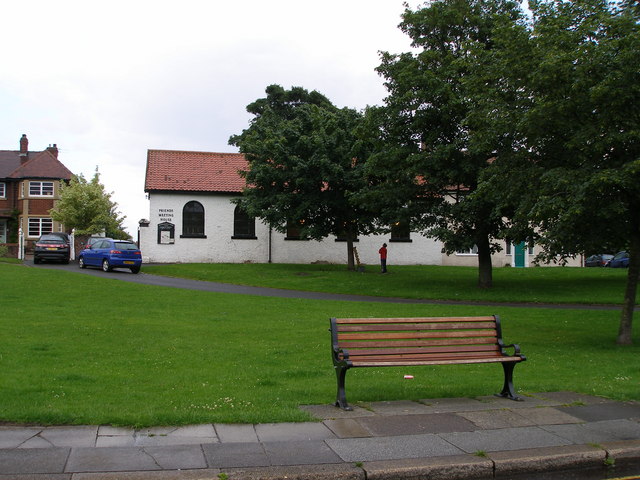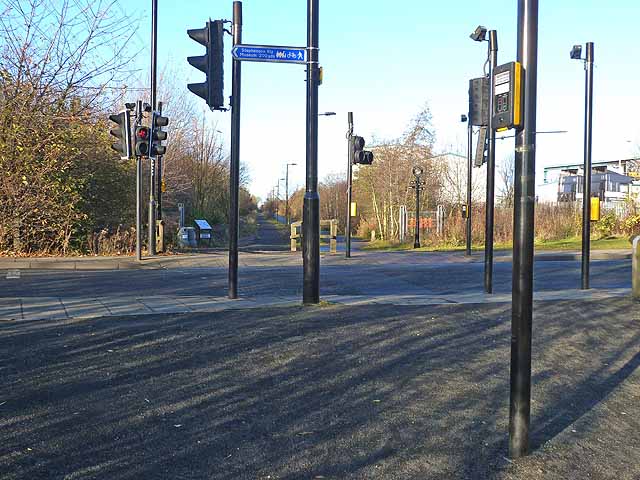Topics > Cumbria > Stainton > Swarthmoor > Swarthmoor Hall
Swarthmoor Hall
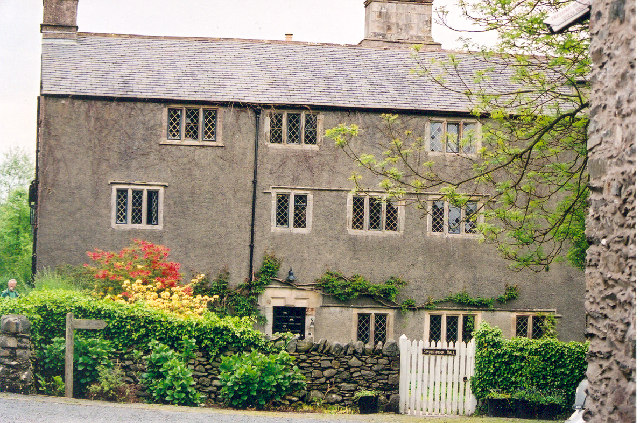 Swarthmoor Hall is a large house, built in c.1568, located in Ulverston, about half a mile east of the village of Swarthmoor. The Hall was the home of the Fell family. George Fox (1624-1691), a founder of the Quaker movement, came to the area in 1652 and was Fox and was later allowed by Judge Thomas Fell (1598–1658) and Margaret Fell (1614 - 1702) to use Swarthmoor Hall as a meeting place. The Hall became a centre for Fox's missionary travels and is considered to be 'the cradle of the Quaker movement'. Margaret Fell became prominent in the Quaker movement and married George Fox in 1669, 11 years after the passing of her first husband. The Religious Society of Friends purchased the Hall in 1951 and it remains in use today as a Quaker retreat. The Hall is Grade II* listed on the National Heritage List for England.
Swarthmoor Hall is a large house, built in c.1568, located in Ulverston, about half a mile east of the village of Swarthmoor. The Hall was the home of the Fell family. George Fox (1624-1691), a founder of the Quaker movement, came to the area in 1652 and was Fox and was later allowed by Judge Thomas Fell (1598–1658) and Margaret Fell (1614 - 1702) to use Swarthmoor Hall as a meeting place. The Hall became a centre for Fox's missionary travels and is considered to be 'the cradle of the Quaker movement'. Margaret Fell became prominent in the Quaker movement and married George Fox in 1669, 11 years after the passing of her first husband. The Religious Society of Friends purchased the Hall in 1951 and it remains in use today as a Quaker retreat. The Hall is Grade II* listed on the National Heritage List for England.Swarthmoor Hall is a mansion in Swarthmoor, in the Furness area of Cumbria in North West England. Furness was formerly in Lancashire. It was the home of Thomas and Margaret Fell, the latter an important player in the founding of the Religious Society of Friends (Quaker) movement in the 17th century. The Hall is designated by English Heritage as a Grade II* listed building. It remains in use today as a Quaker retreat house.
Swarthmoor Hall was built by a lawyer named George Fell about 1568. The Hall was inherited by his son Thomas, a lawyer and later member of parliament, vice chancellor of the Duchy of Lancaster and an influential supporter of Parliament during the English Civil War. In 1634 Thomas married Margaret Askew and she moved into the Hall.
George Fox visited the Hall in 1652. Thomas Fell was travelling as a judge, but Fox had an audience with Margaret Fell, who became interested in his new doctrines. She arranged for him to preach in St Mary's Church in nearby Ulverston and at the Hall. During his time there, many people were convinced of the truth of his teachings.
When Thomas Fell returned home, he was persuaded by his wife and some others to listen to Fox, who successfully appealed to his pro-Parliamentary sentiments. Fell was never totally convinced by Fox's religious teachings, but he did allow his home to be used as a meeting house for the early Friends. Among those connected with the meeting were the missionary preachers Alice and Thomas Curwen, natives of nearby Baycliff, who were active in the Furness district, then in New England, Barbados and Nevis, and later in Huntingdonshire and other parts of England. The meeting continued to use the hall until 1691, when a meeting house was built nearby.
Thomas Fell died in 1658. Eleven years later George Fox married the widowed Margaret Fell and, when not travelling, occasionally lived at Swarthmoor. Fox died in London in 1691 and Margaret died at the Hall in 1702.
The London Yearly Meeting of the Religious Society of Friends purchased the Hall in 1951 for £9,000 and it still belongs to the Religious Society of Friends.
The annual Swarthmore Lecture is one of a series of lectures, started in 1908, addressed to the Britain Yearly Meeting of the Religious Society of Friends. The Quaker-founded Swarthmore College in Pennsylvania was named after Swarthmoor Hall. Swarthmoor is one of the four houses (Swarthmoor, Firbank, Pendle, Briggflatts) at the Quaker boarding school Bootham School in York, and it was one of the three houses at Great Ayton Friends' School.
Visit the page: Swarthmoor Hall for references and further details. You can contribute to this article on Wikipedia.

from https://historicengland.org.u…
SWARTHMOOR HALL - List Entry
- "House. Early C17. Restored late C19 and early C20 after becoming neglected and ruinous. Roughcast with sandstone ashlar dressings and slate roofs. L-plan (with additions in the angle of the …
Added by
Simon Cotterill

from https://commons.wikimedia.org…
Swarthmoor Hall
- "Swarthmoor Hall where Margaret Fell lived and organised the young Religious Society of Friends." Image from: Wilfred Whitten : Quaker Pictures, (The Friends' Quarto Series 1), Hicks, Londres, 1892, p. …
Added by
Simon Cotterill

from https://commons.wikimedia.org…
Margaret Fell (1614-1702)
- Seventeenth century etching by Robert Spence. Public Domain image c/o Wikimedia Commons.
Added by
Simon Cotterill

from https://commons.wikimedia.org…
Portrait of George Fox (1624-1691)
- 17th century portrait attributed to Peter Lely. Public domain image c/o Wikimedia Commons.
Added by
Simon Cotterill
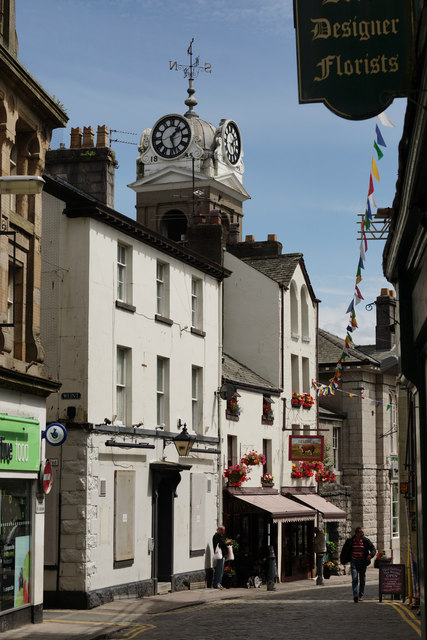
Co-Curate Page
Ulverston
- Overview About Ulverston Map Street View Ulverston is a market town in the South Lakeland district of Cumbria. Help build the Ulverston Timeline Ulverston is a market town in the …


from https://historicengland.org.u…
SWARTHMOOR HALL - List Entry
- "House. Early C17. Restored late C19 and early C20 after becoming neglected and ruinous. Roughcast with sandstone ashlar dressings and slate roofs. L-plan (with additions in the angle of the …
Added by
Simon Cotterill

from https://commons.wikimedia.org…
Swarthmoor Hall
- "Swarthmoor Hall where Margaret Fell lived and organised the young Religious Society of Friends." Image from: Wilfred Whitten : Quaker Pictures, (The Friends' Quarto Series 1), Hicks, Londres, 1892, p. …
Added by
Simon Cotterill

from https://commons.wikimedia.org…
Margaret Fell (1614-1702)
- Seventeenth century etching by Robert Spence. Public Domain image c/o Wikimedia Commons.
Added by
Simon Cotterill

from https://commons.wikimedia.org…
Portrait of George Fox (1624-1691)
- 17th century portrait attributed to Peter Lely. Public domain image c/o Wikimedia Commons.
Added by
Simon Cotterill

Co-Curate Page
Ulverston
- Overview About Ulverston Map Street View Ulverston is a market town in the South Lakeland district of Cumbria. Help build the Ulverston Timeline Ulverston is a market town in the …
List grade: 2*
County: Cumbria
Post code: LA12 0JQ
Grid ref: SD2818677293
Wikipedia: Swarthmoor Hall
